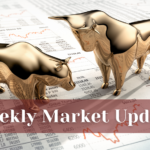Federal Reserve Meeting Recap: Powell Pivot: Confirmed

The Federal Reserve (Fed) ended its two-day Federal Open Market Committee (FOMC) meeting yesterday and there were some notable shifts to monetary policy, although these shifts were largely expected by markets. After months of carefully communicating the Fed’s plan to reduce its asset purchases toward the middle of 2022, Fed Chairman Jerome Powell confirmed that an accelerated plan to reduce its asset purchases and to end its asset purchases altogether by March of next year was now warranted. Powell has noted in the past that the Fed would likely not raise rates while still providing accommodation through its asset purchase plans. By ending the purchase programs quicker, this gives the Fed the “optionality” to increase interest rates as early as May, if necessary.
“This was a bit more hawkish shift than expected,” noted LPL Financial Fixed Income Strategist Lawrence Gillum. “Quicker tapering was expected but three rate hikes projected next year is slightly more than what was expected. That said, the Fed’s job, especially from this point forward, is to prove that it can manage the removal of monetary accommodation without slowing the economic recovery.”
Also released was the updated “dot plot”, which provides the individual member’s projections on the future path of interest rates. As shown in the LPL Research Chart of the Day highlighting the Fed’s dot plot, there were some meaningful changes from the previous version. Now, the median dot of the Committee, in aggregate, reflects three interest rate hikes in 2022. Three months ago, the Committee was evenly split between rate hikes starting in 2022 and 2023. Additionally, there was much more agreement among participants that expect rate hikes in 2023 and 2024. The previous release showed much more disparate views between the doves and hawks on the Committee.
While these dot plot projections are not official policy, it does show that there has been a hawkish shift by the Committee over the last few months. That said, left undecided after the meeting is what the future construct of the FOMC will look like. Recently, President Joe Biden officially nominated Jay Powell to a second four-year term as Chairman and elevated current Fed Governor Lael Brainard to Vice Chair of the Committee. However, there are three open seats remaining to be filled. We’ve been told announcements are coming but until those positions are filled, we won’t know for sure how these dot plots today may change in the new year with the new Committee.
Also of note, four times a year, the Fed updates its economic projections for the next several years as well as its longer-term forecasts. The Fed sees 4.0% GDP growth in 2022 (up from 3.8% in September), and higher inflation expectations with Personal Consumption Expenditure headline and core metrics, their preferred inflation measures, at 2.6% and 2.7% (up from 2.2% and 2.3% in September), respectively. However, the Committee sees inflation falling back to its longer-term trend in 2023.
These releases have pulled forward our view on when rate hikes will take place as well. Previously, we had followed Powell’s guidance and thought the beginning of 2023 or late 2022 was when the first hike could take place. Now, with this Powell Pivot, we think September is the likely start date of rate hikes but acknowledge rate hikes could come earlier. However, what is more important to markets, we believe, is how high and how fast the actual interest rate hiking campaign takes place. A slow deliberate pace of rate hikes, regardless of when lift-off takes place, will likely lead to a better outcome for the economy, and thus markets, than an overly aggressive one.
IMPORTANT DISCLOSURES
This material is for general information only and is not intended to provide specific advice or recommendations for any individual. There is no assurance that the views or strategies discussed are suitable for all investors or will yield positive outcomes. Investing involves risks including possible loss of principal. Any economic forecasts set forth may not develop as predicted and are subject to change.
References to markets, asset classes, and sectors are generally regarding the corresponding market index. Indexes are unmanaged statistical composites and cannot be invested into directly. Index performance is not indicative of the performance of any investment and do not reflect fees, expenses, or sales charges. All performance referenced is historical and is no guarantee of future results.
Any company names noted herein are for educational purposes only and not an indication of trading intent or a solicitation of their products or services. LPL Financial doesn’t provide research on individual equities. All information is believed to be from reliable sources; however, LPL Financial makes no representation as to its completeness or accuracy.
All index and market data from FactSet and MarketWatch.
This Research material was prepared by LPL Financial, LLC.
Securities and advisory services offered through LPL Financial (LPL), a registered investment advisor and broker-dealer (member FINRA/SIPC).
Insurance products are offered through LPL or its licensed affiliates. To the extent you are receiving investment advice from a separately registered independent investment advisor that is not an LPL affiliate, please note LPL makes no representation with respect to such entity.
- Not Insured by FDIC/NCUA or Any Other Government Agency
- Not Bank/Credit Union Guaranteed
- Not Bank/Credit Union Deposits or Obligations
- May Lose Value
For Public Use – Tracking 1- 05223693





